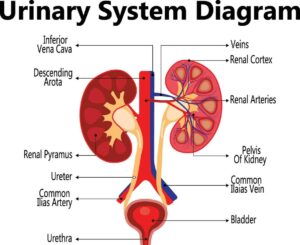
The human urinary system, also known as the excretory system, is responsible for filtering waste from the blood, regulating fluid and electrolyte balance, and removing these waste products from the body through urine. The major components of this system include:
-
Kidneys:
- These are two bean-shaped organs located in the lower back, just below the rib cage.
- They filter waste, excess substances (like water, salts, and urea), and toxins from the blood to produce urine.
- The kidneys also regulate blood pressure, red blood cell production, and the balance of minerals and electrolytes.
-
Ureters:
- These are two muscular tubes that connect the kidneys to the bladder.
- Urine is transported from the kidneys to the bladder via the ureters through peristalsis (muscular contractions).
-
Bladder:
- This is a hollow, expandable organ located in the pelvis. It stores urine until it is ready to be excreted.
- The bladder can hold between 400-600 milliliters of urine, depending on the individual.
-
Urethra:
- This is a tube that connects the bladder to the external opening of the body.
- Urine is expelled from the body through the urethra during urination.
- The length of the urethra varies by gender; in males, it is longer due to its passage through the penis, while in females, it is shorter.
-
Sphincters:
- These are muscles that control the flow of urine. There are two sphincters: the internal sphincter (involuntary control) and the external sphincter (voluntary control).
- The internal sphincter is located at the junction of the bladder and urethra, preventing urine leakage, while the external sphincter helps control urination.
How the system works:
- The kidneys filter the blood, removing waste and excess substances to form urine.
- This filtered urine flows through the ureters into the bladder.
- When the bladder fills, stretch receptors signal the brain that it’s time to urinate.
- The brain then signals the sphincters to relax, allowing urine to be expelled through the urethra.
This system plays a crucial role in maintaining the body’s homeostasis, including hydration, electrolyte balance, and the removal of metabolic waste.
Related Questions:
- Differentiate between:
- What are the conditions necessary for efficient gaseous exchange between an organism and the environment?
- How are gases exchanged in a leaf?
- Explain the difference between respiration and photosynthesis.
- Describe the structure of the human respiratory system.
- Define breathing. Write the mechanism of breathing.
- State the signs and symptoms, causes, and treatments of bronchitis, emphysema, or pneumonia.
- Why is tobacco smoke harmful?
- Explain the structure and function of alveoli in the human respiratory system.
- How does gaseous exchange occur in fish compared to humans?
- Name the ways through which a plant can obtain oxygen.
- Describe the effects of cigarette smoking on the inner walls of the trachea of human beings.
- The diagram shows the percentage of gases in inspired and expired air.
- The figure shows a healthy lung and a diseased lung.
- The diagram shows the structural and functional unit of the lungs.
- Why does breathing rate increase during exercise?
- What role do cilia play in the respiratory system?
- How does carbon monoxide affect oxygen transport in the body?
- Why do mountain climbers experience difficulty in breathing at high altitudes?
- What is the function of the pleural membrane in the lungs?